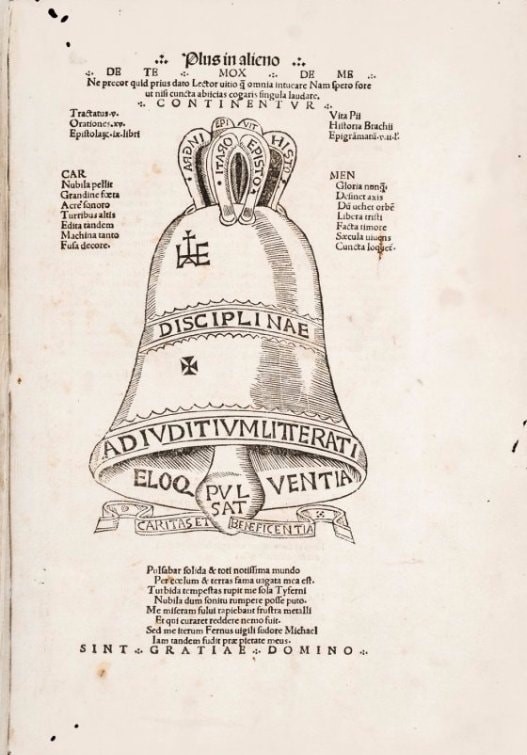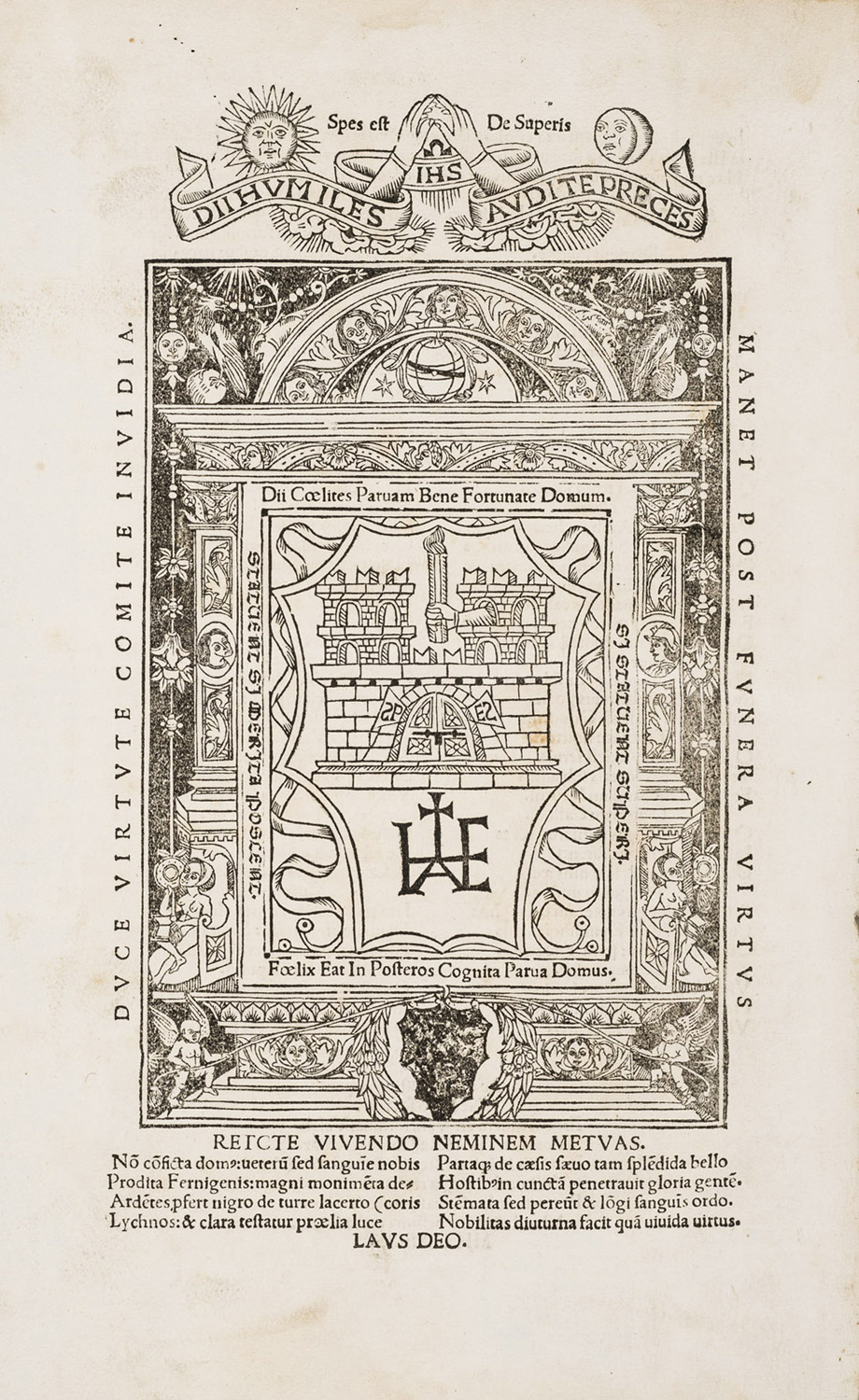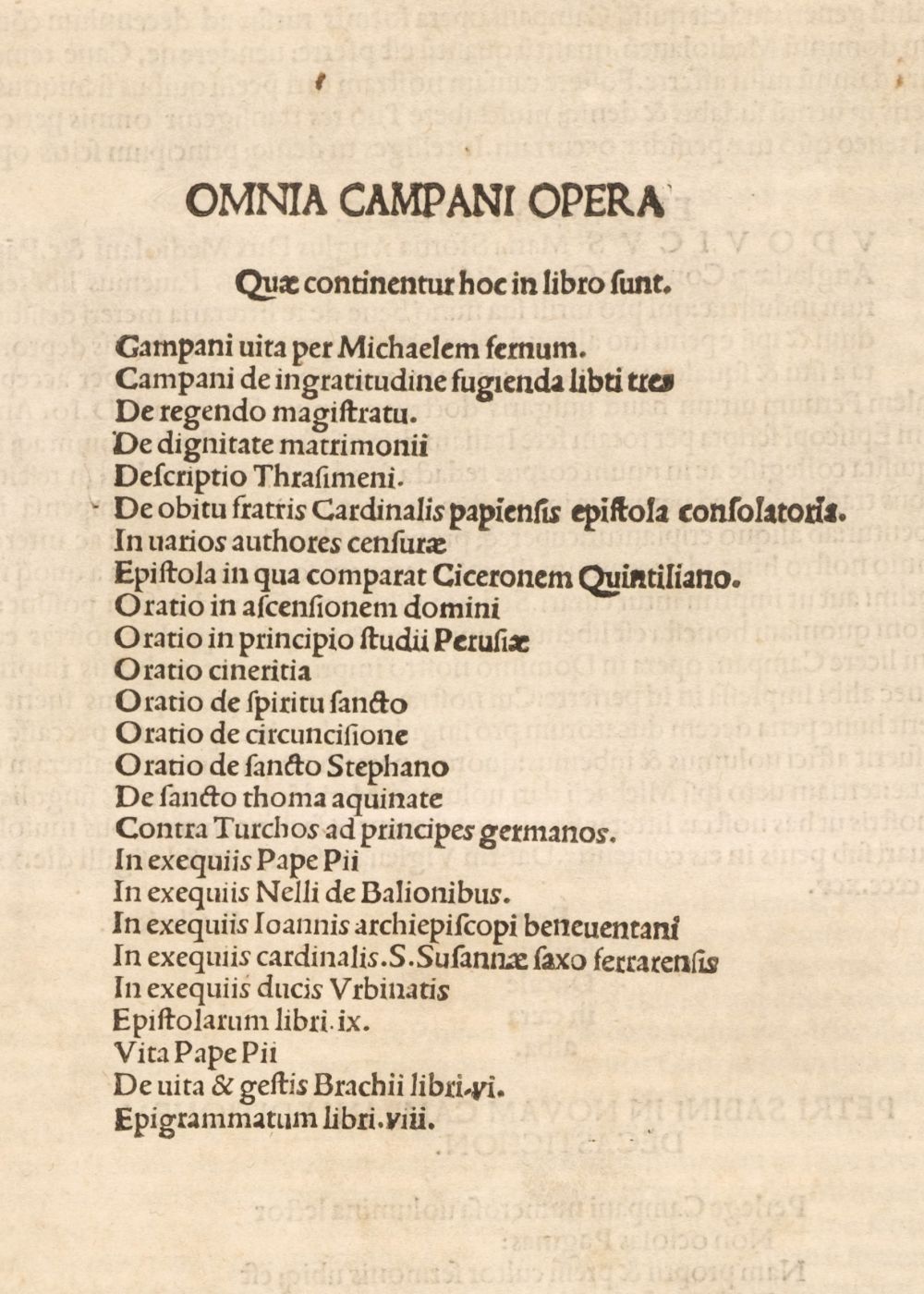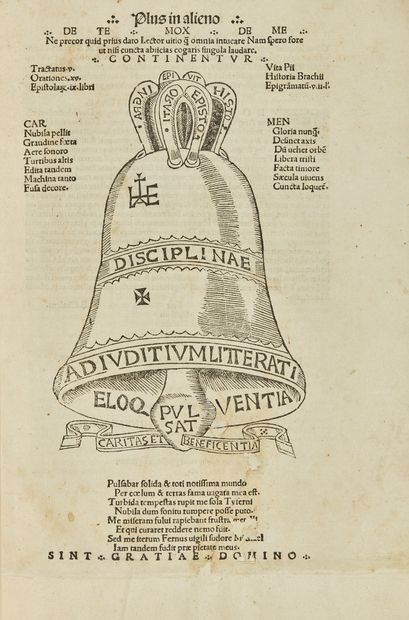CAMPANUS, Johannes Antonius. Opera. Roma, Eucharius Silber, 31 ottobre 1495 folio, mm. 330x220; Contemporary full calf binding, blind tooling: double frames with couple of rules on covers, many medallions with angels and roses, in the middle panel large St. Andrew's cross decorated with floral motifs, spine with 3 ribs with handwritten inscription in the upper compartment, traces of clasps; leaves 304 unnumbered. Large woodcut title page depicting a bell contains woodcut inscriptions and the monogram HAE surmonted by a cross, a full-page plate on leave F4v, numerous woodcut initials, Round and capitals type , with original types of Silber. Marginalia of two different hands, one contemporary, the other later. Sign of dampstain on margins of some leaves, good specimen.
Rare first edition of the opera omnia. Divided in 7 parts, the issue was edited by the Milanese canon Michele Ferno, who put at the text the author's biography. Relevant source of the Renaissance History, the work is especially important for the story of Andrea Fortebraccio, known come Braccio da Montone, the commander of Perugia who was killed by Francesco Sforza near the city of Aquila. Then there are various prayers, the Holy Spirit and Santo Stefano, as well as important prolusions, including the 'De dignitate matrimonii” and "Contra Turcos" addressed to the German princes to urge them to a crusade against the Turks; of particular interest the life of Pope Pius II and St. Thomas Aquinas. In the end of the volume the famous epigram of Michele Ferno against the Roman booksellers, reported by George D. Smith. British: “The woodcut of a bell on 1a contains woodcut inscriptions and the monogram HAE surmonted by a cross, usually interpreted as Eucharius Argenteus Herbipolensis. The same device occurs in the woodcut on 302b.” Eucharius Silber., a native of Würzburg, settled in Rome around 1480 and became one of the most important printers of the city: Latinized his name to Argenteus, uniting the Latin name of Würzburg, Herbipolis; made use of a large number of types, Roman or Gothic, even Greeks, all carefully described in vol IV catalog of incunabula in the British Museum IGI 2383; BMC IV 117; BSB-Ink C-63; GW 5939; Goff C-73; Hain-Copinger 4286; Proctor 3879; Pellechet-Pollain 3180; George D. Smith, Monuments of Early Printing in Germany, The Low Countries. Italy, France And England 1460—1500, n. 41. The Lot is offered with a valid export licence.
CAMPANUS, Johannes Antonius. Opera. Roma, Eucharius Silber, 31 ottobre 1495 folio, mm. 330x220; Contemporary full calf binding, blind tooling: double frames with couple of rules on covers, many medallions with angels and roses, in the middle panel large St. Andrew's cross decorated with floral motifs, spine with 3 ribs with handwritten inscription in the upper compartment, traces of clasps; leaves 304 unnumbered. Large woodcut title page depicting a bell contains woodcut inscriptions and the monogram HAE surmonted by a cross, a full-page plate on leave F4v, numerous woodcut initials, Round and capitals type , with original types of Silber. Marginalia of two different hands, one contemporary, the other later. Sign of dampstain on margins of some leaves, good specimen.
Rare first edition of the opera omnia. Divided in 7 parts, the issue was edited by the Milanese canon Michele Ferno, who put at the text the author's biography. Relevant source of the Renaissance History, the work is especially important for the story of Andrea Fortebraccio, known come Braccio da Montone, the commander of Perugia who was killed by Francesco Sforza near the city of Aquila. Then there are various prayers, the Holy Spirit and Santo Stefano, as well as important prolusions, including the 'De dignitate matrimonii” and "Contra Turcos" addressed to the German princes to urge them to a crusade against the Turks; of particular interest the life of Pope Pius II and St. Thomas Aquinas. In the end of the volume the famous epigram of Michele Ferno against the Roman booksellers, reported by George D. Smith. British: “The woodcut of a bell on 1a contains woodcut inscriptions and the monogram HAE surmonted by a cross, usually interpreted as Eucharius Argenteus Herbipolensis. The same device occurs in the woodcut on 302b.” Eucharius Silber., a native of Würzburg, settled in Rome around 1480 and became one of the most important printers of the city: Latinized his name to Argenteus, uniting the Latin name of Würzburg, Herbipolis; made use of a large number of types, Roman or Gothic, even Greeks, all carefully described in vol IV catalog of incunabula in the British Museum IGI 2383; BMC IV 117; BSB-Ink C-63; GW 5939; Goff C-73; Hain-Copinger 4286; Proctor 3879; Pellechet-Pollain 3180; George D. Smith, Monuments of Early Printing in Germany, The Low Countries. Italy, France And England 1460—1500, n. 41. The Lot is offered with a valid export licence.






.jpg)








Testen Sie LotSearch und seine Premium-Features 7 Tage - ohne Kosten!
Lassen Sie sich automatisch über neue Objekte in kommenden Auktionen benachrichtigen.
Suchauftrag anlegen